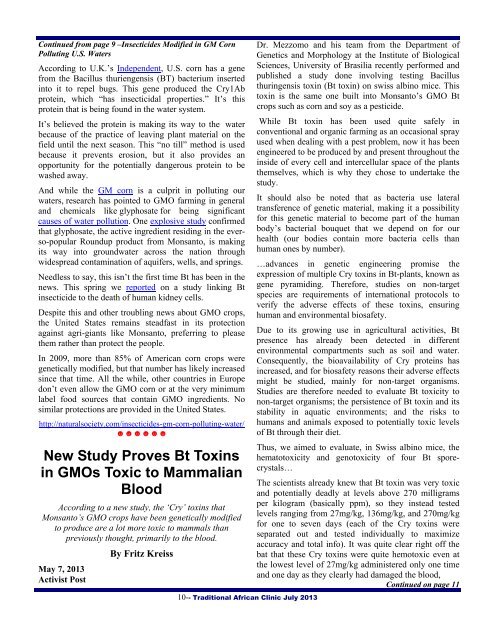toxicity - pesticides, herbicides and insecticides - Blackherbals.com
toxicity - pesticides, herbicides and insecticides - Blackherbals.com
toxicity - pesticides, herbicides and insecticides - Blackherbals.com
You also want an ePaper? Increase the reach of your titles
YUMPU automatically turns print PDFs into web optimized ePapers that Google loves.
Continued from page 9 –Insecticides Modified in GM CornPolluting U.S. WatersAccording to U.K.’s Independent, U.S. corn has a genefrom the Bacillus thuriengensis (BT) bacterium insertedinto it to repel bugs. This gene produced the Cry1Abprotein, which “has insecticidal properties.” It’s thisprotein that is being found in the water system.It’s believed the protein is making its way to the waterbecause of the practice of leaving plant material on thefield until the next season. This “no till” method is usedbecause it prevents erosion, but it also provides anopportunity for the potentially dangerous protein to bewashed away.And while the GM corn is a culprit in polluting ourwaters, research has pointed to GMO farming in general<strong>and</strong> chemicals like glyphosate for being significantcauses of water pollution. One explosive study confirmedthat glyphosate, the active ingredient residing in the everso-popularRoundup product from Monsanto, is makingits way into groundwater across the nation throughwidespread contamination of aquifers, wells, <strong>and</strong> springs.Needless to say, this isn’t the first time Bt has been in thenews. This spring we reported on a study linking Btinsecticide to the death of human kidney cells.Despite this <strong>and</strong> other troubling news about GMO crops,the United States remains steadfast in its protectionagainst agri-giants like Monsanto, preferring to pleasethem rather than protect the people.In 2009, more than 85% of American corn crops weregenetically modified, but that number has likely increasedsince that time. All the while, other countries in Europedon’t even allow the GMO corn or at the very minimumlabel food sources that contain GMO ingredients. Nosimilar protections are provided in the United States.http://naturalsociety.<strong>com</strong>/<strong>insecticides</strong>-gm-corn-polluting-water/☻☻☻☻☻☻New Study Proves Bt Toxinsin GMOs Toxic to MammalianBloodAccording to a new study, the ‘Cry’ toxins thatMonsanto’s GMO crops have been genetically modifiedto produce are a lot more toxic to mammals thanpreviously thought, primarily to the blood.May 7, 2013Activist PostBy Fritz Kreiss10-- Traditional African Clinic July 2013Dr. Mezzomo <strong>and</strong> his team from the Department ofGenetics <strong>and</strong> Morphology at the Institute of BiologicalSciences, University of Brasilia recently performed <strong>and</strong>published a study done involving testing Bacillusthuringensis toxin (Bt toxin) on swiss albino mice. Thistoxin is the same one built into Monsanto’s GMO Btcrops such as corn <strong>and</strong> soy as a pesticide.While Bt toxin has been used quite safely inconventional <strong>and</strong> organic farming as an occasional sprayused when dealing with a pest problem, now it has beenengineered to be produced by <strong>and</strong> present throughout theinside of every cell <strong>and</strong> intercellular space of the plantsthemselves, which is why they chose to undertake thestudy.It should also be noted that as bacteria use lateraltransference of genetic material, making it a possibilityfor this genetic material to be<strong>com</strong>e part of the humanbody’s bacterial bouquet that we depend on for ourhealth (our bodies contain more bacteria cells thanhuman ones by number).…advances in genetic engineering promise theexpression of multiple Cry toxins in Bt-plants, known asgene pyramiding. Therefore, studies on non-targetspecies are requirements of international protocols toverify the adverse effects of these toxins, ensuringhuman <strong>and</strong> environmental biosafety.Due to its growing use in agricultural activities, Btpresence has already been detected in differentenvironmental <strong>com</strong>partments such as soil <strong>and</strong> water.Consequently, the bioavailability of Cry proteins hasincreased, <strong>and</strong> for biosafety reasons their adverse effectsmight be studied, mainly for non-target organisms.Studies are therefore needed to evaluate Bt <strong>toxicity</strong> tonon-target organisms; the persistence of Bt toxin <strong>and</strong> itsstability in aquatic environments; <strong>and</strong> the risks tohumans <strong>and</strong> animals exposed to potentially toxic levelsof Bt through their diet.Thus, we aimed to evaluate, in Swiss albino mice, thehemato<strong>toxicity</strong> <strong>and</strong> geno<strong>toxicity</strong> of four Bt sporecrystals…The scientists already knew that Bt toxin was very toxic<strong>and</strong> potentially deadly at levels above 270 milligramsper kilogram (basically ppm), so they instead testedlevels ranging from 27mg/kg, 136mg/kg, <strong>and</strong> 270mg/kgfor one to seven days (each of the Cry toxins wereseparated out <strong>and</strong> tested individually to maximizeaccuracy <strong>and</strong> total info). It was quite clear right off thebat that these Cry toxins were quite hemotoxic even atthe lowest level of 27mg/kg administered only one time<strong>and</strong> one day as they clearly had damaged the blood,Continued on page 11
















